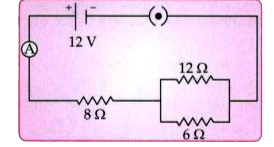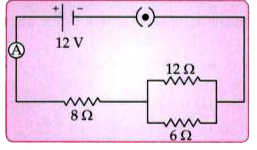Answer questio numbers (a)-(d) on the basis of your understanding of the following paragraph and the related studied concepts:
We know that a battery or a cell is a source of electrical energy. The chemical reaction within the cell generates the potential differences between its two terminals that sets the electrons in motion to flow the current through a resistor or a system of resistors connected to the battery. We also know that to maintain the current, the source has to keep expending its energy. Where does this energy go? A part of the source energy in maintaining the current may be consumed into useful work (like in rotating the blades of an electric fan). Rest of the source energy may be expended in heat to raise the temperature of gadget. We often observe this is our everyday life. For example, an electric fan becomes warm if used continuously for longer time etc. On the other hand, if the electric circuit is purely resistive, that is, a configuration of resistors only connected to a battery, the source energy continually gets dissipated entirely in the form of heat. This is known as the heating effect of electric current. This effect is utilised in devices such as electric heater, electric iron etc.
How is a current establish through a resistor when it is joined to an electric cell?
(b) Why does an electric fan becomes warm if used for some time continuously?
(c) What is the amount of heat produced when a current I flows through a resistor R for time t?
(d) Graphs plotted between heat produced (H) and time (T) for resistor A and B joined in series in an electric circuit are shown here. Which has small resistance A or B and why?

Chemical reactions takng place in a cell generate a potential difference its two terminals which sets electrons in motion thereby establishing a current through the resistor connected in the circuit.
(b) When an electric current passes through the coil of fan, a part of electric energy is consumed in doing useful work (i.e., rotating the blades of fan) but remaining energy is expended in heat due to which fan becomes warm
(c )Heat produced =I2RT joule
(d) As heat produced in a given time is less in resistor A and current flowing through both resistors is same, so resistance of A is less than resistance of B.
Topper's Solved these Questions
- BOOK - U-LIKE SERIESCHAPTER - ELECTRICITY EXERCISE - MULTIPLE CHOICE QUESTIONS40videos
ELECTRICITY
- BOOK - U-LIKE SERIESCHAPTER - ELECTRICITY EXERCISE - TRUE OR FALSE7videos
ELECTRICITY
- BOOK - U-LIKE SERIESCHAPTER - ELECTRICITY EXERCISE - NCERT EXERCISES18videos
ELECTRICITY
- BOOK - U-LIKE SERIESCHAPTER - CBSE SAMPLE QUESTION PAPER 2019 - 20 (SOLVED)EXERCISE - SECTION A10videos
CBSE SAMPLE QUESTION PAPER 2019 - 20 (SOLVED)
- BOOK - U-LIKE SERIESCHAPTER - LIGHT - REFLECTION AND REFRACTION EXERCISE - LONG ANSWER QUESTIONS14videos
LIGHT - REFLECTION AND REFRACTION
Similar Questions
Knowledge Check
- Question 1 - Select One
A resister of 80Ω is connected to a cell and the potential difference across the resistor is 40 V. Then the amount of current that flows through the given resistor is _____ A.
A0.25B0.5C5D2.5
A current of 5 A is flowing through a resistor of 15Ω. Calculate the potential difference between the ends of the resistor.
View SolutionThree resistors are connected to a 12 V battery as shown in the figure given below :

What is the current through the 6 ohm resistor ?View SolutionThree resistors are connected to a 12 V battery as shown in the figure given below :

What is the current through the 8 ohm resistor ?View SolutionFind current passing through the battery and each resistor.
 View Solution
View SolutionFind current passing through the battery and each resistor.
 View Solution
View SolutionA 50V battery is connected across a 10 ohm resistor. The current is 4.5A is flowing through the resistor then the internal resistance of the battery is
View SolutionA 5Ω resistor is connected across a battery of 6 volts. Calculate:
(i) the current flowing through the resistor.
(ii) the energy that dissipates as heat in 10s.View Solution

